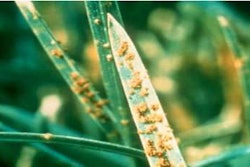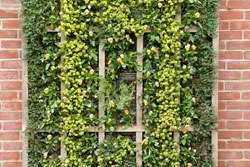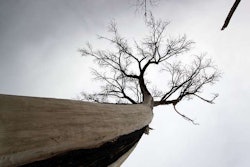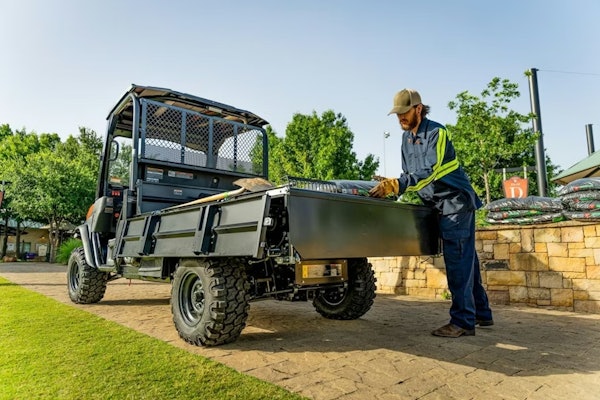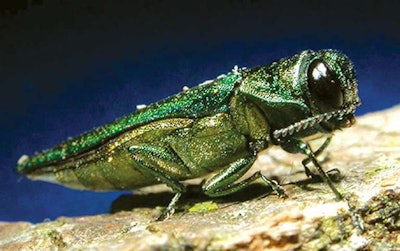 Photo: David Cappaert, Michigan State University, Bugwood.org
Photo: David Cappaert, Michigan State University, Bugwood.orgAs Emerald Ash Borers continue to spread west, early detection will mean the difference between a good defense and total destruction of trees.
Emerald ash borers (EAB) were headline news when they were first discovered in 2002 in southeastern Michigan. Awareness of these exotic beetles heightened as they tore through that area of the state, killing tens of millions of ash trees along the way. Since then, even though headlines have all but disappeared, the pest hasn’t.
Now present in 18 states (most recently in New Hampshire and Kansas) and two provinces in Canada, the EAB continues to threaten ash trees and researchers see no end in sight to how far west it may go. While treatment plans can effectively manage this pest, the challenge lies in detecting it. Once you know for certain your ash tree is infected, chances are, it’s too late to save the tree.
Instead, tracking the EAB and treating trees that are in proximity to where EABs are already known to be is the surest way to protect trees, according to Deborah McCullough, forest entomologist at Michigan State University. “The first step is to know if an ash borer is in or near your area,” she says. “Once you know they are within 15 miles, you really need to start planning what you’re going to do.
“We have made significant progress in the treatment of ash borers,” says McCullough, who has been the lead researcher on EAB in the state of Michigan since its discovery in 2002. “There is no longer any reason to let these trees die unless you just don’t care.”
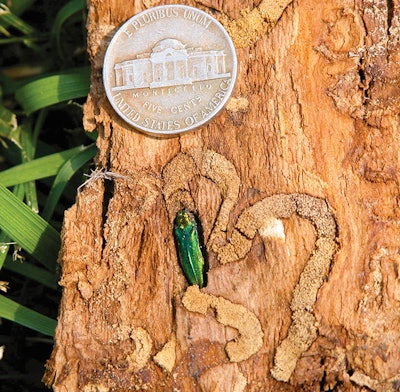 Adult EABs emerge from trees around June, leaving D-shaped exit holes in tree bark. Photo: Eric R. Day, Virginia Polytechnic Institute and State University
Adult EABs emerge from trees around June, leaving D-shaped exit holes in tree bark. Photo: Eric R. Day, Virginia Polytechnic Institute and State UniversityCashing in
It’s been a little more than 10 years since EAB (Agrilus planipennis) made its way onto our continent, but already it has earned a title: the most destructive and costly forest insect to ever invade North America. Native to Asia, it is believed the beetle arrived in wood packing material shipped from there. As adults, the ash borers are not much of a threat, nibbling on foliage. It’s the larvae that do the most damage by feeding on the inner bark of ash trees, disrupting the trees ability to transport nutrients and water.
Conservative estimates for costs associated with treating EAB or removing/replacing trees are staggering. “Annually, cities are spending $850 million a year to deal with this,” McCullough says. “Private households are spending $350 million per year, plus they are sustaining a decrease in the property value of their homes of about $380 million. So if you want to start adding it up, these costs are easily in the billions every year — and that’s lowballing it. This doesn’t even include the ecological impact, which is harder to put a dollar on.”
In 2009, McCullough partnered with other researchers to determine, in dollars, how costly EAB will be during the next decade, given the conservative spread of the pest and looking at landscape trees only in urban areas. “We projected costs for either treating every two years or replacing ash trees with something other than ash. By 2019, the costs would be more than $10 billion — and that’s with us underestimating the spread,” McCullough says.
 In most areas with EAB, quarantines exist that prohibit moving firewood, which could help slow the spread of EAB.
In most areas with EAB, quarantines exist that prohibit moving firewood, which could help slow the spread of EAB.Photo: Kenneth R. Law, USDA APHIS PPQ, Bugwood.org
Close encounters
Gaps in the spread of EAB prove humans are helping these beetles get a little farther down the road. Left to their own devices, they would spread slowly. Transportation of firewood has been blamed as the main method of progression.
“Most of these new infestations are not necessarily that beetles are spreading naturally, but it’s human transport — and most infestations are in the fourth generation before they are discovered,” McCullough says.
Detecting beetles, especially in places they have never been, is more challenging than ridding them from trees.
“We hardly ever know when a tree first becomes infested,” McCullough says. “You would never know unless you peeled the bark off the trees because trees are tolerant of first and second generations, but by the third and fourth generations, you’re going to see the symptoms, and by then it could be too late.”
Knowing if treatments will work depends on how damaged the tree is when you first notice symptoms. If more than half of the canopy is dying, no amount of treatment will bring the tree back.
McCullough says, in addition to checking regularly for things like woodpecker holes (a clue beetle larvae could be present) and new sprouts on the base of the tree, actively tracking the spread of EAB is your best bet for saving trees. Current maps of known EAB populations can be found here. If EAB have been detected within 15 miles of your client, it’s time to figure out how you’ll deal with it.
“If you can be proactive and decide what you’re going to do with these ash trees ahead of time, you won’t have to react,” McCullough says.
If your plan involves treating trees instead of replacing them, you can choose from many products that are labeled for controlling EAB. These products can effectively protect trees from EAB. Make sure, though, that the tree is healthy enough to sustain the treatment. If it’s already in decline, the treatment likely will not work.
“In our studies, and in studies by other universities, with emamectin benzoate (TREE-äge) we are seeing up to three years of almost 100-percent control. Other products have to be applied every year. Dinotefuran (Zylam) can also be extremely effective, specifically on smaller trees, but it won’t get you 100-percent control,” McCullough says.
With any insecticide you choose, know once you see symptoms, you don’t have a lot of time to get the treatment on the tree.
Western swing
Hopes of completely eradicating the EAB in North America have dwindled during the past decade.
Despite very effective insecticides, their ability to infest trees with very few symptoms will continue to ensure their progression.
“Even with the best detection methods we have, it’s just too difficult to find the newest infestations because there are no symptoms,” McCullough says. “If you treated lots and lots of trees in a new area, you’d really slow them down, but there will always be trees that you didn’t know had them. They are too good at building their populations. Total eradication is just not an objective anymore.”
There is no limit to how far west they might go, either. Research on ash species in the western United States revealed there are no species there that are resistant to EAB. “In other words, the species that are being hammered in the East are also being used in landscapes in the West. Plus, ash species that are native to the West also look like they can be colonized by EAB and probably killed.”
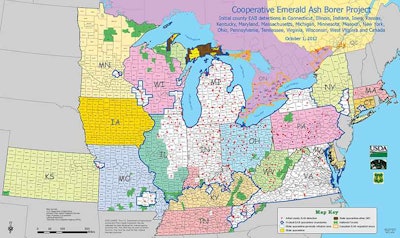 Each year, two or three new states get populated by EAB, mostly as a result of human transport.
Each year, two or three new states get populated by EAB, mostly as a result of human transport.Photo: Cooperative Emerald Ash Borer Project, U.S. Department of Agriculture, Animal and Plant Health Inspection Service, Plant Protection Service (USDA/APHIS/PPQ), and US Forest Service, Oct. 1, 2012

